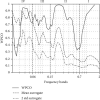Modulation of Interhemispheric Synchronization and Cortical Activity in Healthy Subjects by High-Definition Theta-Burst Electrical Stimulation
- PMID: 35529454
- PMCID: PMC9076342
- DOI: 10.1155/2022/3593262
Modulation of Interhemispheric Synchronization and Cortical Activity in Healthy Subjects by High-Definition Theta-Burst Electrical Stimulation
Abstract
Background: Various forms of theta-burst stimulation (TBS) such as intermittent TBS (iTBS) and continuous TBS (cTBS) have been introduced as novel facilitation/suppression schemes during repetitive transcranial magnetic stimulation (rTMS), demonstrating a better efficacy than conventional paradigms. Herein, we extended the rTMS-TBS schemes to electrical stimulation of high-definition montage (HD-TBS) and investigated its neural effects on the human brain.
Methods: In a within-subject design, fifteen right-handed healthy adults randomly participated in 10 min and 2 mA HD-TBS sessions: unilateral (Uni)-iTBS, bilateral (Bi)-cTBS/iTBS, and sham stimulation over primary motor cortex regions. A 20-channel near-infrared spectroscopy (NIRS) system was covered on the bilateral prefrontal cortex (PFC), sensory motor cortex (SMC), and parietal lobe (PL) for observing cerebral hemodynamic responses in the resting-state and during fast finger-tapping tasks at pre-, during, and poststimulation. Interhemispheric correlation coefficient (IHCC) and wavelet phase coherence (WPCO) from resting-state NIRS and concentration of oxyhemoglobin during fast finger-tapping tasks were explored to reflect the symmetry between the two hemispheres and cortical activity, respectively.
Results: The IHCC and WPCO of NIRS data in the SMC region under Bi-cTBS/iTBS showed relatively small values at low-frequency bands III (0.06-0.15 Hz) and IV (0.02-0.06), indicating a significant desynchronization in both time and frequency domains. In addition, the SMC activation induced by fast finger-tapping exercise was significantly greater during Uni-iTBS as well as during and post Bi-cTBS/iTBS sessions.
Conclusions: It appears that a 10 min and 2 mA Bi-cTBS/iTBS applied over two hemispheres within the primary motor cortex region could effectively modulate the interhemispheric synchronization and cortical activation in the SMC of healthy subjects. Our study demonstrated that bilateral HD-TBS approaches is an effective noninvasive brain stimulation scheme which could be a novel therapeutic for inducing effects of neuromodulation on various neurological disorders caused by ischemic stroke or traumatic brain injuries.
Copyright © 2022 Van-Truong Nguyen et al.
Conflict of interest statement
The authors declare no conflict of interest.
Figures









Similar articles
-
Alterations of the amplitude of low-frequency fluctuation in healthy subjects with theta-burst stimulation of the cortex of the suprahyoid muscles.Neuroscience. 2017 Dec 4;365:48-56. doi: 10.1016/j.neuroscience.2017.09.027. Epub 2017 Sep 23. Neuroscience. 2017. PMID: 28947393
-
Effects of Theta Burst Stimulation on Suprahyoid Motor Cortex Excitability in Healthy Subjects.Brain Stimul. 2017 Jan-Feb;10(1):91-98. doi: 10.1016/j.brs.2016.08.011. Epub 2016 Aug 24. Brain Stimul. 2017. PMID: 27692927
-
Continuous and intermittent theta burst stimulation of primary visual cortex do not modulate resting state functional connectivity: A sham-controlled multi-echo fMRI study.Brain Behav. 2023 May;13(5):e2989. doi: 10.1002/brb3.2989. Epub 2023 Apr 16. Brain Behav. 2023. PMID: 37062900 Free PMC article. Clinical Trial.
-
The effects of theta burst stimulation (TBS) targeting the prefrontal cortex on executive functioning: A systematic review and meta-analysis.Neuropsychologia. 2018 Mar;111:344-359. doi: 10.1016/j.neuropsychologia.2018.02.004. Epub 2018 Feb 10. Neuropsychologia. 2018. PMID: 29438672
-
Efficacy and Time Course of Theta Burst Stimulation in Healthy Humans.Brain Stimul. 2015 Jul-Aug;8(4):685-92. doi: 10.1016/j.brs.2015.03.004. Epub 2015 Mar 26. Brain Stimul. 2015. PMID: 26014214 Review.
References
Publication types
MeSH terms
LinkOut - more resources
Full Text Sources
Miscellaneous

